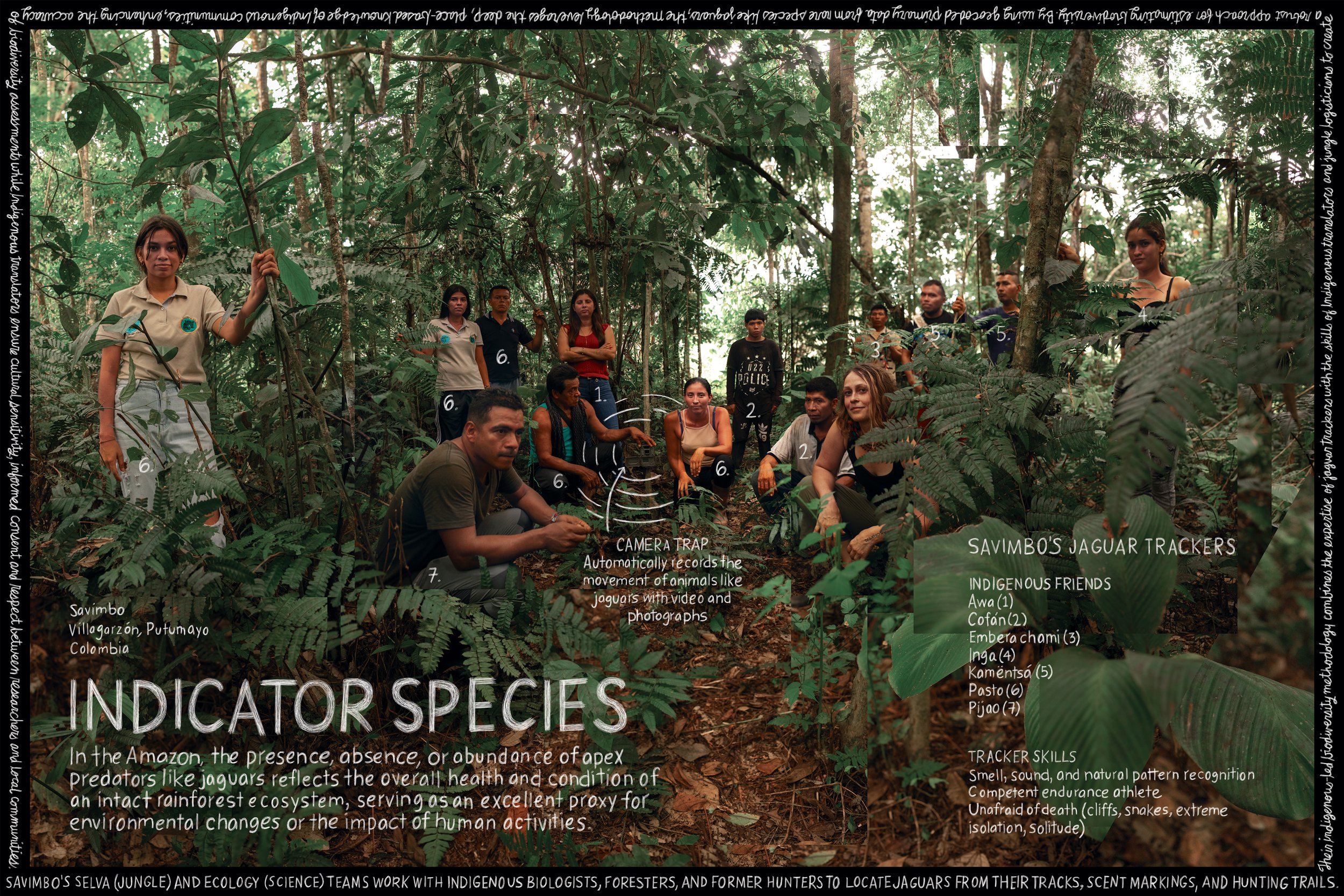
Biodiversity credits
© 2024 Douglas Gayeton for Lexicon of Impacts. All rights reserved
Fair-trade biodiversity credits
#jhonysjaguar
Our biodiversity credits are designed to provide an immediate conservation economy to smallfarmers and Indigenous groups guarding primary forest with intact populations of rare or endangered animals.
Each credit represents one hectare, of 100% conserved biodiversity in a biodiversity hotspot for one month with photo or video evidence. (Yes, you will get the videos. Yes, they are super awesome. Yes, this is the coolest thing ever.)
A coy look at Fernando’s uber-cool (but unpatentable) bush dogs!
Unit
Biodiversity credits are a frontier market. Savimbo is taking a leadership role in defining a unit.
Biodiversity science
ALL THE NERDY DETAILS…
We’re really happy to report that we’ve made significant strides in creating and launching the biodiversity market. Primarily through ethical transfer of traditional ecological knowledge.
Indigenous groups are 6% of the planet’s population, guarding 80% it’s biodiversity and conserving 31% of the planet’s land.
Savimbo was formed to give them autonomy in, and access to climate markets. So we co-wrote a methodology based on their traditional activities and totemic animals — and then used complexity science and emerging technology to translate these activities for financial markets!
Our initial biodiversity methodology was certified by Cercarbono, and the first project is being tracked by Ecoregistry.
It’s being pushed to market by corporate buyers all over the globe and >18 different Indigenous groups in >4 continents and their scientific and social advocates. Early exchange adopters included Xpansiv, Dovu, Boostera, and Emsurge.
The credit uses the Savimbo unit. A cross-market negotiation that is interoperable with other types of biodiversity methodologies around the world!
Now listing on international exchanges
Our biodiversity credit was built by, Indigenous peoples, for Indigenous peoples, then translated to the global market.
We based our methodology on the grassroots activism of Jhony Lopez, and his committed group of grassroots conservationists who fought for >20 years to preserve biodiversity in their home.
A committed team of international biodiversity scientists around the globe have worked for years to bring this standard to the global market and share it open-source. It’s now being applied by local and Indigenous groups in Fiji, Papua New Guinea, Brazil, Ecuador, Peru, Bolivia, Mexico, Panama, Suriname, Gabon, Ghana, Uganda, Kenya, South Africa, The Philipines, Nepal, Cambodia, and the Bahamas for marine, jungle, and savannah ecosystems.
Biodiversity + Impact credit
We made an impact credit because of this diagram. The most biodiverse regions on Earth have inverse conservation funding, and they are controlled by Indigenous and local communities who often don’t have full land rights.
Markets that transact biodiversity, and require full land title, not only reward bad acting, they fail to pay the people who do the most for other species.
Our impact credit uses the same unit and methodology as our certified credits. All credits have full measurement, reporting, and verification. They all have full topography and multiple levels of ground-vetted attestations for land control. But they are sold by Indigenous groups and smallfarmers that are excluded from the global certification markets because of structural inequity. Either they don’t have full land title, or the land titles they do have, can’t be corrected.
In all cases, the sellers of these credits have land tenure, local bills of sale, and/or hunting rights that all parties and multiple levels of government the region attest to in writing with a notary. Our ground team speaks to all their neighbors including neighboring Indigenous leaders and validates personally there is no conflict over the land occupancy. Then they pass the same rigorous scientific validation as our certified credits. We think they deserve to be rewarded for protecting rare species. We hope you do too.
Pirinon et al. 2024, Science
2025 update: We’re working hard to find a globally respected third-party financial auditor who will validate and verify our primary data on MRV credits science, topography, and land rights. This would be a market first and we think a significant step forward for corporate purchasers who are looking for alternatives to certification.
Our biodiversity credits
Biodiversity credit
$10
This pre-certified biodiversity credit follows all the rules. The best science, full land title, and full monitoring, reporting, and verification. Sold direct from Indigenous Peoples and local communities and listing and trading on international exchanges.
You want full credentials and results — this is your credit.
Impact credit
$6.5
This uncertified biodiversity credit breaks market rules for all the right reasons. Same, methodology, and MRV as our certified biodiversity credits. But this credit is not certifying because of unfair land rights access for Indigenous Peoples and local communities.
You want double impact, equity AND biodiversity — this is your credit.

















